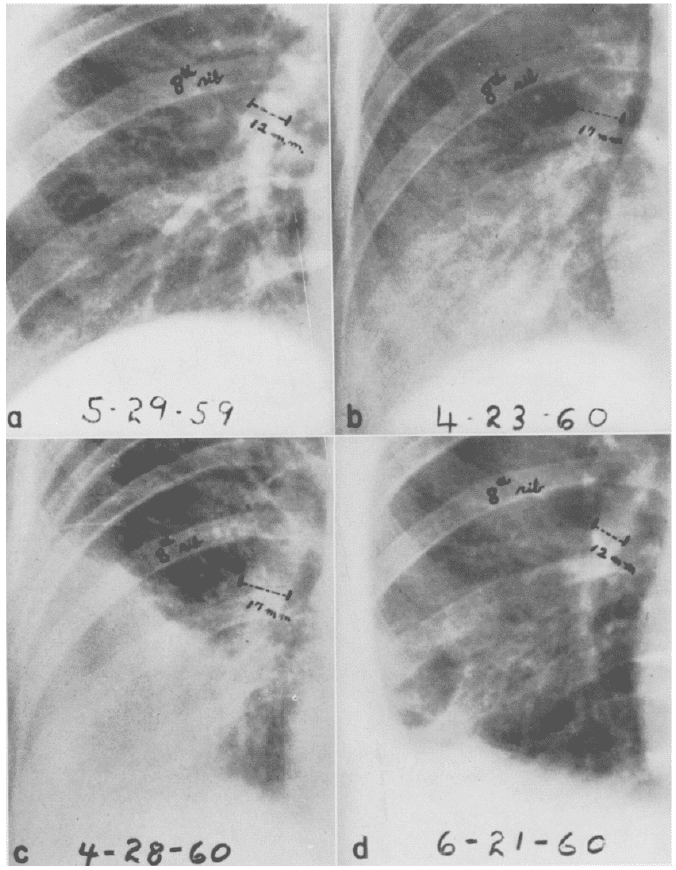Chang sign
Chang sign on chest x-ray describes a dilated left or right descending pulmonary artery with an abrupt change in calibre, with an amputated appearance. This sign is most commonly associated with with pulmonary infarction and pulmonary hypertension following pulmonary embolism
History
1962 – Chang published an extensive review of 1,085 consecutive chest X-rays to determine the average diameter of the left and right descending pulmonary artery on a PA chest x-ray. He determined the upper limit of normal for the right descending as 16mm in males, and 15mm in females; and for the left descending <17mm as normal. Measurements were made at the widest point of the artery, usually at the level of the 8th/9th rib.
1965 – Chang published findings of 23 consecutive patients with pulmonary infarcts diagnosed at the Man Memorial Hospital between 1959 and 1962. He noted dilatation of a descending pulmonary artery occurred in all 23 cases of pulmonary infarction. Dilation ranged from 17-22mm on the right (19 cases) and 17-26mm on the left (4 cases)
The most constant roentgen signs of pulmonary embolism in our patients were dilatation of the descending pulmonary artery, parenchymal densities and pleural fluid. The earliest consistent sign was widening of a previously normal descending pulmonary artery. This sign usually appeared within 24 hours of the onset of chest pain and shows its maximal measurements within two to three days. Dilatation of the descending pulmonary artery persisted for a period of one to two weeks and usually returned to normal in three to four weeks. The elevation of diaphragm which was described by Fleischner (1962) was seen in 18 (78%) of our series.
Chang 1965
- a) Preoperative CXR. Right descending pulmonary artery 12 mm.
- b) Pulmonary infarction. Homogeneous density in right lower lobe. Dilated right descending pulmonary artery measuring 17 mm suggesting acute pulmonary hypertension
- c) Five days later. Right pleural effusion and persistent densities in the right lower lobe. Right descending pulmonary artery 17 mm
- d) Two months later. Decreased right pleural fluid and resolving pulmonary infarcts with linear scars. Right descending pulmonary artery again 12 mm.
Associated Persons
- Nils Westermark (1892 – 1980) [Westermark sign 1938]
- Aubrey Otis Hampton (1900 – 1955) [Hampton hump 1940]
- Felix George Fleischner (1893 – 1969) [Fleischner sign 1959]
- C. H. Joseph Chang (1929 – 2017) [Chang sign 1965]
- Antonio Palla (1950 – ) [Palla sign 1983]
Alternative names
- Chang’s sign
- Palla sign
References
- Chang CH. The normal roentgenographic measurement of the right descending pulmonary artery in 1,085 cases. Am J Roentgenol Radium Ther Nucl Med. 1962; 87: 929-35.
- Chang CH. The normal roentgenographic measurement of the right descending pulmonary artery in 1,085 cases and its clinical application. Part II. Clinical application of the measurement of the right descending pulmonary artery in the radiological diagnosis of pulmonary hypertensions from various causes. Nagoya J med. Sci. 1965;28:67-80. [Chang sign]
- Chang CH, Davis WC. A Roentgen sign of Pulmonary Infarction. Clin Radiol. 1965; 16: 141-7.
- Palla A, Donnamaria V, Petruzzelli S, Rossi G, Riccetti G, Giuntini C. Enlargement of the right descending pulmonary artery in pulmonary embolism. AJR Am J Roentgenol. 1983 Sep;141(3):513-7. [Palla sign]
- Bickle I. Plain Film Signs in Pulmonary Embolism (with CT correlate). Eurorad 2009, Case 7735
- Cadogan M. CXR eponyms in pulmonary embolism. LITFL
eponymictionary
the names behind the name
Doctor in Australia. Keen interest in internal medicine, medical education, and medical history.

